INTRODUCTION
Having spent 2 weeks in the Kruger proper in 2012 we knew we would return. Africa is a very special place and being able to bird independently in an area the size of Wales makes it extra special. Although the Kruger is a game park the very size of it means you are birding in a truly wild environment.
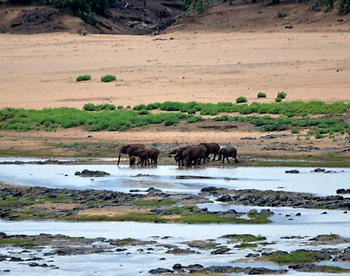 Once again we turned to Birding Africa to organise everything except our international flights. This included accommodation within the park, internal flights, car-hire and environmental permits. Our itinerary was straightforward, we would fly from London to Johannesburg then onto Skukuza airport which is situated within the park boundaries, pick up our hire car and overnight at Skukuza camp; we would then travel to Olifants camp where we would spend our second night. On day three we would travel to Punda Maria camp which is situated in the far north of the park, where we would spend the next 6 days exploring this bird rich environment. We would then retrace our steps back to Olifants camp where we would spend the next 7 days exploring the central area. Then back to Skukuza, where we would spend our last 6 days birding the south; a total of 21 days birding and game viewing in the Kruger.
Once again we turned to Birding Africa to organise everything except our international flights. This included accommodation within the park, internal flights, car-hire and environmental permits. Our itinerary was straightforward, we would fly from London to Johannesburg then onto Skukuza airport which is situated within the park boundaries, pick up our hire car and overnight at Skukuza camp; we would then travel to Olifants camp where we would spend our second night. On day three we would travel to Punda Maria camp which is situated in the far north of the park, where we would spend the next 6 days exploring this bird rich environment. We would then retrace our steps back to Olifants camp where we would spend the next 7 days exploring the central area. Then back to Skukuza, where we would spend our last 6 days birding the south; a total of 21 days birding and game viewing in the Kruger.
FLIGHTS
Our chosen international carrier was British Airways, we would fly from London Heathrow to Oliver Tambo, Johannesburg, on the new super Jumbo Airbus A380, traveling “World Traveller Plus” at a total cost of £2,964:12.
ACCOMODATION
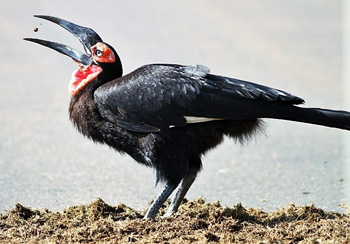 Our accommodation was what we considered the best situated available at the 3 rest camps. We chose a Family Cottage at Punda because they are the only ones with air conditioning, a must in the heat of the tropical north. At Olifants we chose the best bungalows available with a river view. Skukuza we again plumped for a riverside bungalow, great views of the river and close to all the amenities. All our accommodation being room only. Restaurants, which have recently been upgraded, both in meals offered and environs are located at all the rest camps so breakfasts and evening meals are readily available. Shops selling groceries and petrol stations are also located at all the main camps should you wish to self-cater. Picnic sites selling food and drinks are also located throughout the park, so missed breakfasts due to early starts can be mitigated by lunches out or just a snack and a cold drink.
Our accommodation was what we considered the best situated available at the 3 rest camps. We chose a Family Cottage at Punda because they are the only ones with air conditioning, a must in the heat of the tropical north. At Olifants we chose the best bungalows available with a river view. Skukuza we again plumped for a riverside bungalow, great views of the river and close to all the amenities. All our accommodation being room only. Restaurants, which have recently been upgraded, both in meals offered and environs are located at all the rest camps so breakfasts and evening meals are readily available. Shops selling groceries and petrol stations are also located at all the main camps should you wish to self-cater. Picnic sites selling food and drinks are also located throughout the park, so missed breakfasts due to early starts can be mitigated by lunches out or just a snack and a cold drink.
CAR HIRE
If we had a regret from our previous visit it was that our hire vehicle was a “Toyota Corolla”, a decent enough car, but lacked the height to see over some of the taller grasses encountered. This trip we had a Honda CRV, this has greater ground clearance and was the same as we have back home, so no learning how it all works. Once the paperwork was completed we were happy to drive away.
INTERNAL FLIGHTS
Our internal flights were from Oliver Tambo, Johannesburg to Skukuza and return, our carrier was South African Air Link a subsidiary of South African Airways.
ENTRY & CONSERVATION PERMITS
Birding Africa obtained an “International couples wild card” which is the most economical for our type of trip.
TRIP COSTS
- Accommodation, car hire, internal flights and permits cost £3,940
- International flight £2,964:12
- Cost of meals, drink, Petrol etc £1,500
- Total Cost £8,404:12

The costings above can be reduced considerably if you are:-
- Prepared to choose standard accommodation.
- Fly standard economy with your chosen international airline.
- Choose a low tariff compact car.
All accommodation has the facility to cook with rudimentary stoves in the chalets, but if you use the BBQ option as most of the South Africans do, then self-catering costs can be minimised. All accommodation has its own “brai” better known to us as BBQ’s.
LITERATURE
Having visited the Kruger a couple of years earlier all of our literature had already been obtained. These included Kruger National Park (Globetrotter Travel Guide), The Pocket Photoguide to Mammals of Southern Africa, Roberts Bird Guide: Kruger National Park and Adjacent Lowveld & Sasol Birds of Southern Africa; these publications covered most bases.
DIARY – Fri 26/02/2016

We left home at 11:30am for our journey down to Heathrow, leaving in plenty of time in case of any hold-ups on the M40; as “sod’s law” predicts, our journey was problem free and we made the airport in record time. Our BA flight left a little over half an hour late. We were assured by the captain we would have a very smooth overnight flight to Johannesburg and should arrive on time. The flight was anything but smooth with the seatbelt signs on and off more times than a bride’s nighty. His prediction however that we would arrive on time was correct.
Day 1 – 27/02/2016
Arriving at Johannesburg on time we were greeted by a queue for customs control of epic proportions, snaking its way for several hundreds of metres. Surely the powers that be must realise that when the world’s largest airliner arrives disgorging the best part of 500 passengers, 5 customs gates would be insufficient. We eventually got through and picked up our cases from the baggage hall; we then ran the gauntlet of several men claiming to be official “meet and greet” members of staff offering to take you to the internal flights terminal. Having been before we were wise to this ruse. Our internal flight to Skukuza airport left on time for the 50 minute flight. The flight actually took 20 minutes longer because of an aborted landing, just feet above the runway. Apparently the captain had been issued with incorrect wind direction and strength information, not the best start to a trip. We picked up our hire car and headed for Skukuza camp just 15 mins from the airport. With temperatures over 30°C we settled into our bungalow before taking a steady walk along the River Sabi within the confines of the camp. We then readied ourselves for our evening meal.
New birds of day 1 – Egyptian Goose, African Fish Eagle, Blacksmith Lapwing, Common Ringed Plover, Wood Sandpiper, Common Sandpiper, Laughing Dove, Speckled Mousebird, Woodland Kingfisher, Pied Kingfisher, Little Bee-eater, Chin-spot Batis, Dark-capped Bulbul, Wire-tailed Swallow, Pearl-breasted Swallow, Greater Blue-eared Starling, Spotted Flycatcher, Ashy Flycatcher, House Sparrow, African Pied Wagtail, Lemon-breasted Canary.
I should point out that I will only add new birds for the daily tally. An attached matrix shows all daily sightings.
Day 2 – 28/02/2015


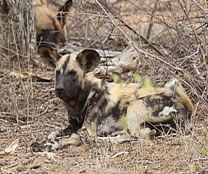

Today, although we were travelling north, gave us our first real chance to game watch & bird. The day dawned overcast with no crescendo of bird song; were we really in Africa? Birding was to coincide with our move to Olifants camp some 156km away. The birding may have been slow but the game viewing was excellent. A pack of 10 wild dogs within a mile of Skukuza, a leopard eating its kill up a tree just after lunch and 4 male lions by mid-afternoon.
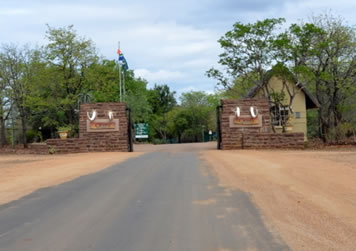 Birding was slow, something we would probably have to accept. Kruger Park is gripped in the worst drought in living memory. The ground is bare of vegetation and many of the trees are already losing their leaves. We had been informed that many of the migratory birds that swell Kruger’s numbers have already left; Cuckoos, Sunbirds and Weavers we have been told will be very thin on the ground.
Birding was slow, something we would probably have to accept. Kruger Park is gripped in the worst drought in living memory. The ground is bare of vegetation and many of the trees are already losing their leaves. We had been informed that many of the migratory birds that swell Kruger’s numbers have already left; Cuckoos, Sunbirds and Weavers we have been told will be very thin on the ground.
New birds of day 2 – Common Ostrich, Helmeted Guineafowl, Crested Francolin, Swainson’s Spurfowl, Yellow-billed, African Openbill, Saddle-billed and Marabou Storks, Hadada Ibis, Striated Heron, Grey Heron, Goliath Heron, Little Egret, Hamerkop, Black Kite, Hooded Vulture, White-backed Vulture, Gabar Goshawk, Tawny Eagle, Marshal Eagle, Kori Bustard, Water Thick-knee, Three-banded Plover, African Mourning Dove, Namaqua Dove, African Green Pigeon, Grey Go-away Bird, Burchell’s White-browed Coucal, Verreaux’s Eagle-Owl, Lilac-breasted Roller, European Roller, European Bee-eater, Southern Carmine Bee-eater, Red-billed Hornbill, Yellow-billed Hornbill, Black-collared Barbet, Magpie Shrike, Lesser Grey Shrike, Forked-tail Drongo, Chestnut-backed Sparrow-Lark , Red-breasted Swallow, Rattling Cisticola, Arrow-marked Babbler, Wattled, Cape Glossy, Burchell’s and Red-winged Starlings, Red-billed Oxpecker, Red-billed Buffalo Weaver.
NORTHERN KRUGER
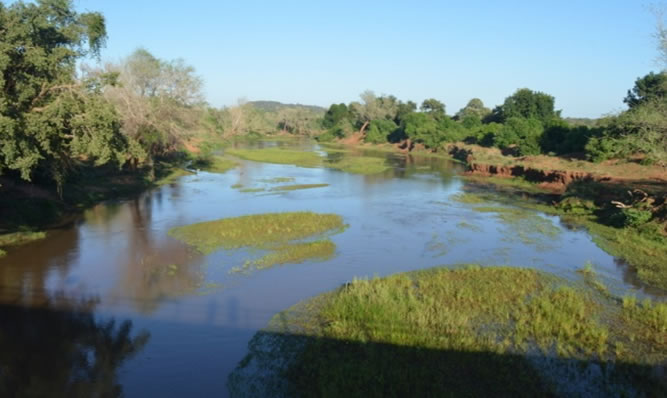
The far north of the Kruger is above the tropic of Capricorn and therefore has a far more tropical feel than further south. The area is dominated by 2 large river systems the Luvuvhu & Limpopo. Both these river corridors are dominated by large, mature hardwoods. This is the only area in the Kruger where the Baobab tree can be found. With the large abundance of fruiting trees, the area is a magnet for birds and is justifiably known as the birding mecca of the park.
Day 3 – 29/2/2016
Today was the big push to Punda Maria camp, Kruger’s most northern rest camp and some 214km from Olifants. We left Olifants at 06:15 making Mopani rest camp in time for breakfast. We had a brief toilet stop in Shingwedzi camp before arriving at Punda by late afternoon. Again the birding was very slow; we were travelling many kilometres between sightings, something we would need to come to terms with during the trip. We managed our second lion sighting in as many days, a superb single Lioness just 20metres from the road, obviously engrossed in something as she never gave us a glance. Our accommodation was a 3 bedroomed family bungalow; it was nice to have a bit more living space.
New birds of day 3 – Crested Guineafowl, White-faced Whistling Duck, Squacco Heron, Great Egret, Yellow-billed Kite, Black-chested Snake Eagle, Bateleur, Steppe Eagle, Amur Falcon, Black-winged Stilt, Crowned Lapwing, African Jacana, Tambourine Dove, African Palm Swift, Little Swift, Sabota Lark, Southern Grey-headed Sparrow, Cinnamon–breasted Bunting.
Day 4 – 1/03/2016
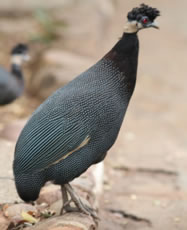
As today was going to be our first proper days birding we decided to do Pafuri picnic site and Crook’s Corner; both these are on the banks of the Luvuvhu and Limpopo rivers and we were hopeful that these renowned birding sites should provide some much needed birding. All the guide books talk about Frank the resident bird expert at Pafuri, who knows the whereabouts of all the special birds of the area. Well, Frank was on annual leave, so no help there then. It was enjoyable that in a couple of areas on the long entrance track to the picnic site the birds almost became abundant, something we had taken for granted when visiting Africa previously. On our return to camp, we had our first evening meal at Punda Maria and it was outstanding, the finest grilled Chicken we have ever had. We joined another couple of Brits for the 2hour night drive when we managed 2 species of Nightjar and a couple of confiding Spotted Eagle Owls.
New birds of day 4
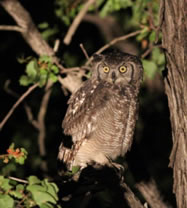
White-crowned Lapwing, Kittlitz’s Plover, Greenshank, Emerald-spotted Wood Dove, Spotted Eagle Owl, European Nightjar, Fiery-necked Nightjar, Common Swift, White-fronted Bee-eater, Southern Ground Hornbill, Red-backed Shrike, Barn Swallow, Meves’s Starling, Southern Black Flycatcher, Southern Red Bishop, White-winged Widowbird, Long-tailed Paradise Whydah.
Day 5 – 2/03/2016
Today we decided to do the Mahonie loop, this is a gravel road that runs for some 26km and is renowned for outstanding birding. It starts a couple of kilometres from the camp and winds itself around some small wooded hills, finishing again a couple of kilometres from the camp entrance. Much of this drive follows a small watercourse which in normal years would be a very productive habitat; again the birding was slow with just enough birds and game to maintain interest. With temperatures hovering around 32°C we returned to camp by early afternoon. We paid a visit to the waterhole bird hide and apart from a couple of Cape Turtle Doves nothing else showed. We completed the day with another excellent evening meal.
New birds of day 5 – African Hawk Eagle, African Hoopoe, Crowned Hornbill, Crested Barbet, Black-backed Puffback, African Paradise Flycatcher, Tawney-flanked Prinia, Long-billed Crombec, Yellow-billed Oxpecker, Blue Waxbill.
Day 6 – 3/03/2016
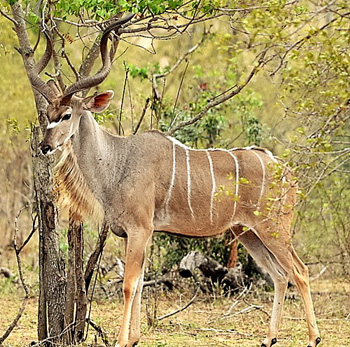 Today we decided to head south, the sky was overcast and leaden, with more than a hinted promise of rain. Our first stop was Babalala picnic site, the huge fig tree there was supposed to be a magnet for birds from miles around. Once again we had been seeing “politician’s clouds” they promise a lot and deliver very little; we entered the picnic site in bright sunshine. With only a couple of species registered we continued on to our final destination, Shingwedzi camp reaching there a little after 13:00; 4 lionesses sitting on the side of the road was the highlight of the trip. We lunched on a toasted sandwich and a cup of tea. On our return journey to Punda, Jude made a great spot of a Verreaux’s Eagle Owl hidden in dense foliage in a large Marula tree. We were also royally entertained by a family of Ground Hornbills busily extracting dung beetles and seeds from the Elephant bombs deposited in the road. We made the camp by mid-afternoon and we had another excellent evening meal before we joined our guide for our 2 hour night game drive. A Honey Badger and female Leopard were the highlights.
Today we decided to head south, the sky was overcast and leaden, with more than a hinted promise of rain. Our first stop was Babalala picnic site, the huge fig tree there was supposed to be a magnet for birds from miles around. Once again we had been seeing “politician’s clouds” they promise a lot and deliver very little; we entered the picnic site in bright sunshine. With only a couple of species registered we continued on to our final destination, Shingwedzi camp reaching there a little after 13:00; 4 lionesses sitting on the side of the road was the highlight of the trip. We lunched on a toasted sandwich and a cup of tea. On our return journey to Punda, Jude made a great spot of a Verreaux’s Eagle Owl hidden in dense foliage in a large Marula tree. We were also royally entertained by a family of Ground Hornbills busily extracting dung beetles and seeds from the Elephant bombs deposited in the road. We made the camp by mid-afternoon and we had another excellent evening meal before we joined our guide for our 2 hour night game drive. A Honey Badger and female Leopard were the highlights.
New birds of day 6 – Black-crowned Night Heron, Half-collared Kingfisher, African Grey Hornbill, Golden-tailed Woodpecker, Violet-backed Starling, Yellow-fronted Canary, Neddicky.
Day 7 – 4/03/2016
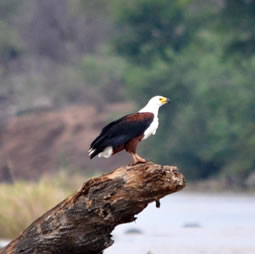 Today we would head up north to Pafuri once again as the Luvuvhu river corridor offered marginally better birding. With the alarm going off at 05:30 we were on the road for a little after 06:00.To facilitate as early an arrival as possible we stuck to the tar. By 07:30 we were on the main river bridge. From here we also paid both picnic site and “Crook’s Corner” a second visit. Both sites were as unproductive as our previous visit. We returned to Punda slowly, using the S60 gravel road. We arrived back at camp by 15:30. Half an hour in the bird hide produced a single Cape Collared Dove. New birds are becoming as rare as hens teeth!
Today we would head up north to Pafuri once again as the Luvuvhu river corridor offered marginally better birding. With the alarm going off at 05:30 we were on the road for a little after 06:00.To facilitate as early an arrival as possible we stuck to the tar. By 07:30 we were on the main river bridge. From here we also paid both picnic site and “Crook’s Corner” a second visit. Both sites were as unproductive as our previous visit. We returned to Punda slowly, using the S60 gravel road. We arrived back at camp by 15:30. Half an hour in the bird hide produced a single Cape Collared Dove. New birds are becoming as rare as hens teeth!
New birds of day 7 – Spur-winged Goose, Cape Vulture, Bohm’s Spinetail, Black-headed Oriole, Yellow Bishop and Mosque Swallow.
Day 8 – 5/03/2016
As this was to be our last full day in the far north of the park and with the big push south tomorrow, we thought we would stay local. We had always intended to walk the “flycatcher trail” which runs along a ridge on the side of the hill situated within the confines of the camp. With the morning overcast and cool, it seemed the ideal opportunity. We had downloaded some literature that lists more than 50 species commonly seen on this trail. We started the walk at 06:30 and saw precisely none. We didn’t even hear a bird call!! Undaunted, we treated ourselves to a modest breakfast of bacon & eggs (first at the camp) and then re-did the Mopani loop; with the temperatures beginning to soar we returned to camp by mid-afternoon and packed, ready for an early start south tomorrow.
New birds of day 8 – Natal Spurfowl, Common Scimitarbill, Cardinal Woodpecker, Eastern Nicator, White-bellied Sunbird.
Day 9 – 6/03/2016
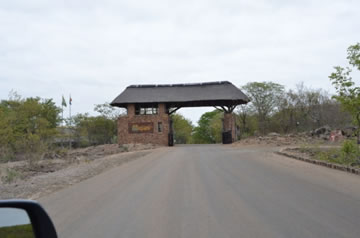 Sadly we left Punda this morning as soon as the gates were opened at 05:30 for the long push south back to Olifants. We stopped for a few minutes at Babalala picnic site before making our way to Shingwedzi for a comfort stop and tea break. Breakfast today consisted, as it had for most of the trip, of cold buttered toast. We made Mopani by mid-day, scanning the lake for anything we had missed on the way up. There is a certain monotony to driving at a constant 50kph for hours on end as Jude can testify. Her shout of “PAT” woke me from my slumbers as we were careering into the bush. The first time in 46 years marriage that I have fallen asleep at the wheel. Our final stop was a whistle-stop visit to the Matambeni bird hide which looks over the Letaba river; a flock of some 200> Egyptian Geese gathered on the bend of the river. We made Olifants by mid-afternoon.
Sadly we left Punda this morning as soon as the gates were opened at 05:30 for the long push south back to Olifants. We stopped for a few minutes at Babalala picnic site before making our way to Shingwedzi for a comfort stop and tea break. Breakfast today consisted, as it had for most of the trip, of cold buttered toast. We made Mopani by mid-day, scanning the lake for anything we had missed on the way up. There is a certain monotony to driving at a constant 50kph for hours on end as Jude can testify. Her shout of “PAT” woke me from my slumbers as we were careering into the bush. The first time in 46 years marriage that I have fallen asleep at the wheel. Our final stop was a whistle-stop visit to the Matambeni bird hide which looks over the Letaba river; a flock of some 200> Egyptian Geese gathered on the bend of the river. We made Olifants by mid-afternoon.
New birds of day 9 – Knob-billed Duck, Reed Cormorant, Black-winged Kite, Dark Chanting Goshawk, African Goshawk, Ruff, Double-banded Sandgrouse, Purple Roller, Malachite Kingfisher, Dusky Lark. Marsh Sandpiper, Lesser-masked Weaver.
CENTRAL KRUGER
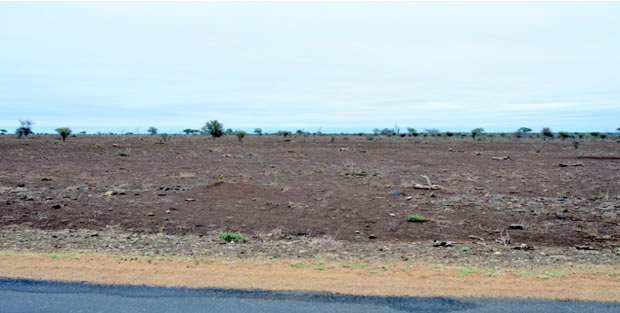
Central Kruger has 2 main habitats; thorn scrub and savannah type grasslands. The picture above shows part of the savannah that is prevalent around Satara. The absolute lack of any grass, which in normal years would be knee high, clearly demonstrates the effect the drought has had. In 2013 this area abounded with breeding Quelea; tens of thousands of nests festooned almost every bush. Korhans, sandgrouse, larks and pipits abounded. Wildebeest, Zebra, Elephants, Gazelle and Ostrich gave this area the archetypal feel of the African savannah.
Day 10 – 7/03/2016
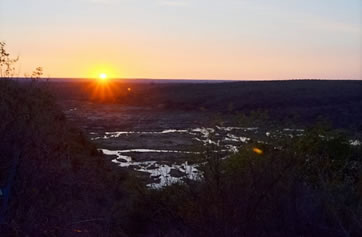 Refreshed from the exploits of the day before, we arose at 06:30 to a wonderful sun-rise and headed for the S92-91; a gravel loop that takes in the Olifants river low-level river crossing. Birding and game viewing was fairly slow. From here we took the S39 Timbavati loop, another gravel road of approximately 46km long. Along this track we would visit Ratel Pan, which again was dry. During our 2013 trip it produced several good water birds and a resident Mocking Cliff Chat. The resident Scops Owls at the Timbavati picnic site had also moved on. A slice of cold toast and a swallow of water saw breakfast done. We continued on to Satara Camp, which we made in time for a wonderful Pizza and a welcome cup of tea. We had the car washed whilst we walked round the camp looking for more birds. With temperatures nudging 40°C we made our way back to Olifants and an air-conditioned sanctuary.
Refreshed from the exploits of the day before, we arose at 06:30 to a wonderful sun-rise and headed for the S92-91; a gravel loop that takes in the Olifants river low-level river crossing. Birding and game viewing was fairly slow. From here we took the S39 Timbavati loop, another gravel road of approximately 46km long. Along this track we would visit Ratel Pan, which again was dry. During our 2013 trip it produced several good water birds and a resident Mocking Cliff Chat. The resident Scops Owls at the Timbavati picnic site had also moved on. A slice of cold toast and a swallow of water saw breakfast done. We continued on to Satara Camp, which we made in time for a wonderful Pizza and a welcome cup of tea. We had the car washed whilst we walked round the camp looking for more birds. With temperatures nudging 40°C we made our way back to Olifants and an air-conditioned sanctuary.
New birds of day 10 – Lappet-faced Vulture, African Harrier Hawk, Black Crake, Green Sandpiper, White-crested Helmetshrike, Southern White-crowned Shrike, Southern Black Tit, Groundscraper Thrush.
Day 11 – 8/03/2016
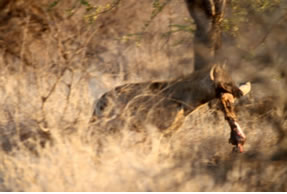
Awake at 06:00 we could hear the “call to arms” of not too distant Hyenas. We were on the road by 06:30 heading east into the rising sun. We hadn’t gone more than a kilometre from camp when the noise from the Hyenas became apparent; they were squabbling over the remains of a recent kill. A full adult came out of the bush carrying a large portion of an unfortunate’s leg; what a start to another day in the African bush. Our travels today took in the S44 gravel loop following the Olifants River for about 14km. From here we took the S93 up to Letaba Camp approximately 26km where we stopped for breakfast and to bird the camp. We then followed the H1-6 taking in all of the loops, then on to the Matambeni bird hide via the S62. Temperatures were now in the 40’s so we retraced our steps back to Letaba to replenish cold drinks and return to Olifants by mid-afternoon. After an early evening meal we embarked on a 2hour night drive, taken in what became an increasingly strong wind, a prelude to the electrical storm and deluge that was to follow. We saw mating Leopards, a Verreaux’s Eagle Owl playing “none shall pass” in the centre of the bridge and standing defiantly in the teeth of the gale plus a very obliging Civet.
New birds of Day 11 – African Spoonbill, Purple Heron, Great White Pelican, Brown Snake Eagle, Striped Kingfisher, Giant Kingfisher, Grey-headed Bushshrike, Brubru, Red-billed Firefinch.
Day 12 – 9/03/2016
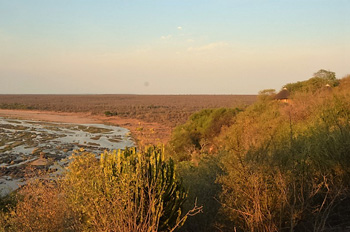
Day 12 dawned grey and very wet; the overnight deluge had created a torrent of water cascading down our access path; somewhat reminiscent of a small mountain stream, the water made its way past the bungalow down the steep hillside to the river below. With the rain still falling we breakfasted at the bungalow, hot buttered toast today! By 08:00 we were getting itchy feet and although still raining we made our way back to Letaba via the tarmacked H1-5. We then took the gravel S95 just some 4km in length, but with several good sightings of small birds. The rain had all but stopped by the time we took the gravel S47 some 37km in length. Although this wasn’t prolific bird-wise, we had great views of a pack of wild dogs resting at the side of the track. We returned to Olifants by the same route, getting back by late afternoon.
New birds of Day 12 – Black Cuckooshrike, Yellow-breasted Apalis, Little Sparrowhawk.
Day 13 – 10/03/2016
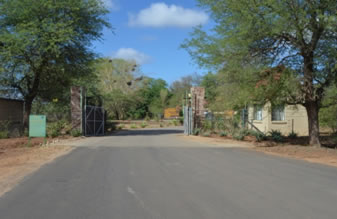
We were up at 06:10 to a cool grey dawn and on the road to Satara by 06:30. A young Hyena and then a White Rhino were both seen within 5 minutes of leaving the confines of the camp. With light rain now beginning to fall we drove slowly along the H1-4.This road runs through what can be loosely termed as savannah; so there should be savannah specialties like bustards, korhans, sandgrouse, larks and pipits. In reality the area was a desolate wasteland of scorched bare earth. A Lion pride at a Buffalo kill livened up the proceedings. From Satara we took the H6 to N’wanetsi picnic site and look-out. We then took the gravel S100 Loop; a Serval was without doubt the highlight of the day and possibly the trip. We entered Satara camp for lunch at 13:30, leaving for Olifants by the same route as this morning. A detour to the Olifants low-level bridge produced little.
New birds of day 13 – Brown-headed Parrot, White-browed Robin Chat, Spectacled Weaver.
Day 14 – 11/03/2016
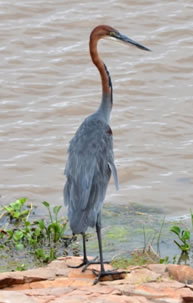
Large claps of thunder and heavy rain were heard in the small hours, so it was no surprise to waken to leaden skies and a very soggy Kruger. Because of the conditions we left a little later than usual sometime around 07:30, toast for breakfast and cheese & tomato cobs for lunch. We took the tar H1-5 to Letaba, then the H1-6 which has become a firm favourite, as it is one of the only roads where there always seem to be a few of the smaller birds. Then we took the S62 back to the Matambeni bird hide, which wasn’t as productive as previously, although a very impressive Goliath Heron gave good close views. A cup of tea and comfort stop at Letaba was made prior to our return via the S46 loop and H15.
New birds of day 14 – African Sacred Ibis, Osprey, Sand Martin, White-throated Robin Chat, Mocking Cliff Chat.
Day 15 – 12/03/2016
 With winds picking up overnight and the very real chance of more substantial rain we decided to leave day 15’s plans on hold. In reality the expected rain fell further north, turning our river brown with silt and approximately twice the volume. We decided to take the S90 gravel road, renowned for both good bird and game viewing. During our last trip it was by far the most productive; what a difference a drought makes! A male Leopard sighting helped to keep spirits up. From the S90 we took the S41 joining the S100 back to Satara. We took the opportunity to get the car washed in Satara as it was beginning to resemble a Sahara rally car covered in red clay dust. We returned to Olifants via the H1-4 tar.
With winds picking up overnight and the very real chance of more substantial rain we decided to leave day 15’s plans on hold. In reality the expected rain fell further north, turning our river brown with silt and approximately twice the volume. We decided to take the S90 gravel road, renowned for both good bird and game viewing. During our last trip it was by far the most productive; what a difference a drought makes! A male Leopard sighting helped to keep spirits up. From the S90 we took the S41 joining the S100 back to Satara. We took the opportunity to get the car washed in Satara as it was beginning to resemble a Sahara rally car covered in red clay dust. We returned to Olifants via the H1-4 tar.
New birds of day 15 – Peregrine Falcon, African Scops Owl, Red-headed Quelea, Common Waxbill, Sabota Lark, Horus Swift.
Day 16 – 13/03/2016
Today we returned to the hot and humid conditions we had endured for the first 2 weeks of the trip. We left Olifants after breakfast, which we had at the restaurant – scrambled eggs on rye toast with roasted cherry tomatoes. Leaving Olifants by 07:30 we took the tar H1-4 calling in at Satara for a comfort stop. We then headed for Tshokwane picnic site where we purchased a sandwich for lunch. We arrived at Skukuza at 13:30. Not much birding took place today; it was a day to get where you are going as quickly as you could.
New birds of day 16 – Little Grebe, Woolly-necked Stork, Brown-hooded Kingfisher, Brown-crowned Tchagra.
SOUTHERN KRUGER
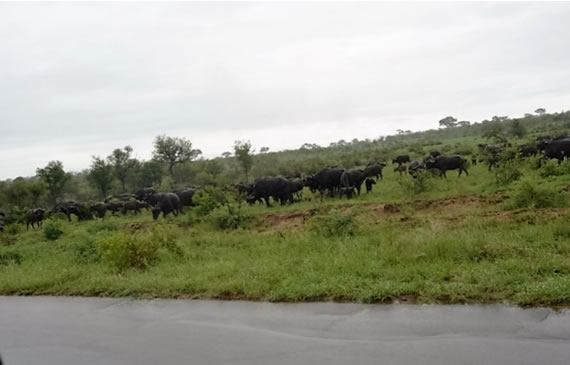
Southern Kruger is a mosaic of thorn scrub and open grassland populated by trees and bushes. Being influenced by the nearby Drakensburg Mountains, this part of the park receives more rain than either the central or north of the park. Although there was a good covering of grass around Berg-en-Dal, it was around Pretoriuskop where the grass was above knee-height, the norm for the Kruger at this time of the year.
Day 17 – 14/03/2016
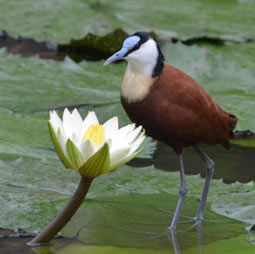 We were up at 05:30 this morning to grey skies and light rain. We were off to Lake Panic to do a couple of hours birding before breakfast. We parked the car and as we got out the rain came down in biblical proportions. By the time we had made the hide some 50metres away we were soaked to the skin. We had read reports that with general birding in the park being so slow, a spot in the Panic hide was at a premium. We had read that with a maximum of eight cars allowed on the car park a queueing system had evolved. With our early start there was only one car parked. The birding was a little disappointing, although several good photo opportunities did present themselves. After a full English, we drove down to Lower Sabie, getting there just in time for a cup of tea. Several dead Hippos were encountered today; a testament to how hard these animals are being affected by the drought. A scramble at Sunset Dam ensued as everyone was attempting to get uninterrupted views of the few birds on show. A slow drive back, retracing our steps, saw us back to Skukuza by mid-afternoon.
We were up at 05:30 this morning to grey skies and light rain. We were off to Lake Panic to do a couple of hours birding before breakfast. We parked the car and as we got out the rain came down in biblical proportions. By the time we had made the hide some 50metres away we were soaked to the skin. We had read reports that with general birding in the park being so slow, a spot in the Panic hide was at a premium. We had read that with a maximum of eight cars allowed on the car park a queueing system had evolved. With our early start there was only one car parked. The birding was a little disappointing, although several good photo opportunities did present themselves. After a full English, we drove down to Lower Sabie, getting there just in time for a cup of tea. Several dead Hippos were encountered today; a testament to how hard these animals are being affected by the drought. A scramble at Sunset Dam ensued as everyone was attempting to get uninterrupted views of the few birds on show. A slow drive back, retracing our steps, saw us back to Skukuza by mid-afternoon.
New birds of day 17 – Red-knobbed Coot, Whiskered Tern.
Day 18 – 15/03/2016
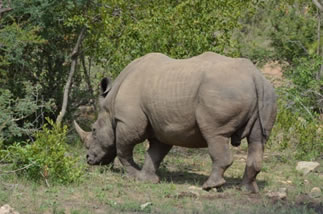 The alarm went off at 05:20; we were out by 05:45 for the long trek down to Berg-en-Dal. We chose the S114 gravel down, which goes almost all of the 70km to Berg. As the surface was not the best we have travelled on in Kruger it took most of the morning. We were astounded at how much greener this part of the park was; they had obviously had their fair share of the late rains. We had a late breakfast consisting of the best scrambled eggs we had had during our trip. We returned via the H3, stopping off at the Afsaal picnic site. It used to be renowned for having very obliging Scops Owls and in fact we snapped them when we were last in Kruger in 2013. Alas no more, they have disappeared like so many of Kruger’s birds during this drought. Berg-en-Dal is renowned for its population of White Rhinos and with 7 seen within an hour, we are testament to that. We returned to Skukuza by early afternoon and then to Lake Panic late afternoon, but again the birding was very slow. Several large crocodiles were feeding on the bloated remains of another hapless Hippo.
The alarm went off at 05:20; we were out by 05:45 for the long trek down to Berg-en-Dal. We chose the S114 gravel down, which goes almost all of the 70km to Berg. As the surface was not the best we have travelled on in Kruger it took most of the morning. We were astounded at how much greener this part of the park was; they had obviously had their fair share of the late rains. We had a late breakfast consisting of the best scrambled eggs we had had during our trip. We returned via the H3, stopping off at the Afsaal picnic site. It used to be renowned for having very obliging Scops Owls and in fact we snapped them when we were last in Kruger in 2013. Alas no more, they have disappeared like so many of Kruger’s birds during this drought. Berg-en-Dal is renowned for its population of White Rhinos and with 7 seen within an hour, we are testament to that. We returned to Skukuza by early afternoon and then to Lake Panic late afternoon, but again the birding was very slow. Several large crocodiles were feeding on the bloated remains of another hapless Hippo.
New birds of day 18 – Levaillant’s Cuckoo, Black Stork, Red-faced Mousebird, Pin-tailed Whydah.
Day 19 – 16/03/2016
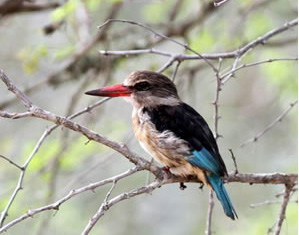 Today we decided to have a much easier day and bird locally. We were well down on the small pretty jobs so we decided to have a look at Skukuza nursery. The thought behind this was that any flowering shrubs and plants may attract the nectar feeders, birds we have failed to locate during the whole trip. Good idea, but sadly lacking in reality. Although the nursery held many plants, very few if any were flowering. We had a quick look at the golf course before we took the H1-2 tar. From here we took the S83 gravel known as the Marula Loop. An hour spent in the Panic bird hide produced a couple of new birds; a pair of Brown-hooded Kingfishers appeared to be prospecting for a nest, they were clearly excavating the entrance to a hole in the bank. We returned to Skukuza via the H4-1in time to watch “Gormless George” produce his 2016 budget, nothing to get really excited about.
Today we decided to have a much easier day and bird locally. We were well down on the small pretty jobs so we decided to have a look at Skukuza nursery. The thought behind this was that any flowering shrubs and plants may attract the nectar feeders, birds we have failed to locate during the whole trip. Good idea, but sadly lacking in reality. Although the nursery held many plants, very few if any were flowering. We had a quick look at the golf course before we took the H1-2 tar. From here we took the S83 gravel known as the Marula Loop. An hour spent in the Panic bird hide produced a couple of new birds; a pair of Brown-hooded Kingfishers appeared to be prospecting for a nest, they were clearly excavating the entrance to a hole in the bank. We returned to Skukuza via the H4-1in time to watch “Gormless George” produce his 2016 budget, nothing to get really excited about.
New birds of day 19 – White-breasted Cormorant, Brown-hooded Kingfisher, Bearded Woodpecker, Green-winged Pytilia.
Day 20 – 17/03/2016
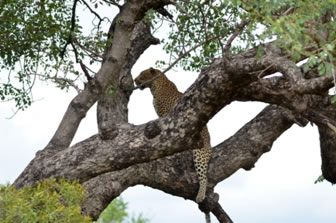 Today was our last full day of birding in the park; it would follow a familiar path to so many this trip. Up and out by 06:30, toast made for later consumption. Today we would follow the H1-1 tar down to Pretoriuskop, calling in at Transport waterhole and Shitlhave Dam; we would then transfer to the Fayi loop S14 gravel. Several new birds were recorded today but the highlights have to be the Honey Badger unexpectedly seen in daylight and the leopard asleep in a tree adjacent to the road. We were back at Skukuza by mid afternoon for a well-earned rest.
Today was our last full day of birding in the park; it would follow a familiar path to so many this trip. Up and out by 06:30, toast made for later consumption. Today we would follow the H1-1 tar down to Pretoriuskop, calling in at Transport waterhole and Shitlhave Dam; we would then transfer to the Fayi loop S14 gravel. Several new birds were recorded today but the highlights have to be the Honey Badger unexpectedly seen in daylight and the leopard asleep in a tree adjacent to the road. We were back at Skukuza by mid afternoon for a well-earned rest.
New birds of day 20 – Green Wood-Hoopoe, Monotonous Lark, Red-faced Cisticola, Lazy Cisticola, Red-collared Widowbird.
Day 21 – 18/03/2016
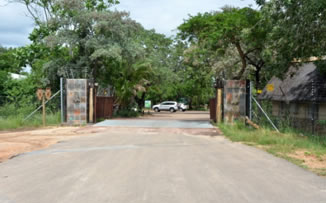 Today was our last day in Africa; our flight to Johannesburg was mid afternoon so we had a bit of time to kill. Rising a little later than previously at 07:00 we packed then took the car to be fuelled and cleaned whilst we had a full English; we don’t normally eat the rubbish provided by the airlines so our breakfast may have to sustain us for 24hrs. After breakfast we walked around the camp, and incredibly managed to find a couple of new birds! We then drove slowly around the Marula loop before arriving at Skukuza airport to start our long journey home. In fact our birding hadn’t been concluded; as we sat in the departure lounge a Cattle Egret flew past, number 201 and the last bird for the conclusion of the trip.
Today was our last day in Africa; our flight to Johannesburg was mid afternoon so we had a bit of time to kill. Rising a little later than previously at 07:00 we packed then took the car to be fuelled and cleaned whilst we had a full English; we don’t normally eat the rubbish provided by the airlines so our breakfast may have to sustain us for 24hrs. After breakfast we walked around the camp, and incredibly managed to find a couple of new birds! We then drove slowly around the Marula loop before arriving at Skukuza airport to start our long journey home. In fact our birding hadn’t been concluded; as we sat in the departure lounge a Cattle Egret flew past, number 201 and the last bird for the conclusion of the trip.
New birds of Day 21 – Cattle Egret, White-browed Scrub Robin, Bronze Mannikin.
The total number of species seen during the trip was 201; this was well below our expectations, but due to the lack of many migrants as a result of the severe drought, a fair number.
MOANS, GROANS & WONDERFULl MOMENTS
Moan – With the technology to put a man on the moon, why can’t we surface gravel roads that don’t become corrugated with wear. On these worst roads you spend more time scanning the road surface, than the surrounding bush for birds and mammals.
Groan – The complete disorganisation that confronts you at the airport’s arrivals hall; hundreds of weary travellers being disgorged into passport control to be processed by 5 passport officers.
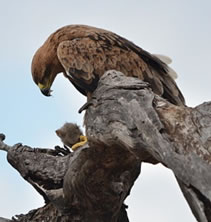 Moan – Since our trip of 2013 the catering within the camps has been put out to franchise. This has improved the standard of food immeasurably. Punda Maria was probably the best, especially when you consider resources. With the exception of 1 meal, all the food produced was outstanding. Mug & Bean has the franchise for Olifants and again the standard was very good. Skukuza has Cattle Baron, this franchise as the name suggests specialises in steaks and again the majority of the food served was OK although the service was probably the worst encountered. We ordered our second Chateaubriand on the forth night. One was ordered as medium and the other medium to well done. The medium was delivered bleeding onto the plate, with less than half the steak consumed it became apparent it was raw. The manager was called who offered 10% off the meal, which equated to £2-50 on a £25-00 meal. When you consider that the steak was probably 85% of the cost of the meal, we felt the management were being a little disingenuous. We declined the offer and paid the bill in full.
Moan – Since our trip of 2013 the catering within the camps has been put out to franchise. This has improved the standard of food immeasurably. Punda Maria was probably the best, especially when you consider resources. With the exception of 1 meal, all the food produced was outstanding. Mug & Bean has the franchise for Olifants and again the standard was very good. Skukuza has Cattle Baron, this franchise as the name suggests specialises in steaks and again the majority of the food served was OK although the service was probably the worst encountered. We ordered our second Chateaubriand on the forth night. One was ordered as medium and the other medium to well done. The medium was delivered bleeding onto the plate, with less than half the steak consumed it became apparent it was raw. The manager was called who offered 10% off the meal, which equated to £2-50 on a £25-00 meal. When you consider that the steak was probably 85% of the cost of the meal, we felt the management were being a little disingenuous. We declined the offer and paid the bill in full.
Groan – The almost total lack of bird song. We realise that at the time of year we went bird song would have diminished as the breeding season came to a close, but we have been in Africa at this time before and our recollection is of a very strong dawn chorus.
Wonderful Moments –
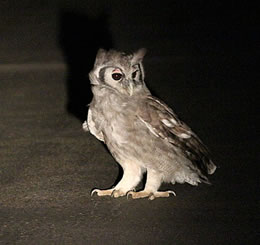
It would take far too long to catalogue all the memorable moments as they occurred daily. 2 sightings of Wild Dog packs, 6 sightings of Leopard, numerous sightings of Lions including several females attempting to stop a Hippo from finding sanctuary in the Olifants River and all from the patio of our bungalow. A Serval strolling majestically past us on the other bank of a small river. A Honey Badger in broad daylight. Porcupine with kit and a Hyena carrying an enormous leg at high speed.
The mammal sightings were very special, but the birds too had their moments, a gang of Ground Hornbills sifting through Elephant dung so close to the car that we couldn’t focus the cameras. A Tawny Eagle ripping apart a Dwarf Mongoose in a tree adjacent to the road. The Verreaux’s Eagle Owl standing in the teeth of a gale in the middle of the bridge refusing to move; apparently it was catching the bats that roosted under the bridge. By standing on the road the bats were silhouetted against the night sky, making them easier to catch.
CONCLUSION
Although the majority of the park is enduring a severe drought which had a detrimental effect on the birding, this could in no way diminish the total enjoyment a trip like this gives. The beauty of birding on the African continent is that there is always something of interest happening, you literally never know what is around the next corner, we were in the park for 21 days and every day something happened to make that day memorable. The logistics were left to Birding Africa to organise and again what they did was exemplary, we wouldn’t use any other company when visiting Africa. The accommodation at all 3 camps was very good. This was probably the best holiday we have ever had.
If you want to visit Africa, and would like to do it independently then we would thoroughly recommend a trip to the Kruger. You can fly directly into the park so the environment is very, very safe. The whole area is well signed so you can’t get lost even in a park that is larger in size than countries like Wales or Israel.
Wildlife Sightings
- Chacma Baboon 10+ sightings
- Vervet Monkey 15+ sightings
- African Wild Dogs 2 sightings
- Side‐striped Jackal 1 sighting
- Black‐backed Jackal 5 sightings
- Honey Badger 2 sightings
- African Civet 1 sighting
- Small‐spotted Genet 3 sightings
- Large‐spotted Genet 1 sighting
- Slender Mongoose 3 sightings
- Dwarf Mongoose 8 sightings
- Spotted Hyena 7 sightings
- Leopard 6 sightings
- Lion 9 sightings
- Serval 1 sighting
- African Wild Cat 3 sightings
- Elephants numerous sightings
- Hippopotamus 10+ sightings
- White Rhinoceros 5 sightings
- Warthog numerous sightings
- Plains Zebra numerous sightings
- Blue Wildebeest numerous sightings
- Giraffe 12+ sightings
- Tsessebe 1 sighting
- Grey Duiker numerous sightings
- Klipspringer 1 sighting
- Steenbok numerous sightings
- Impala daily sightings
- Buffalo numerous sighting
- Greater Kudu numerous sighting
- Nyala numerous sightings
- Bushbuck numerous sightings
- Eland 1 sighting
- Waterbuck 10+ sightings
- Scrub Hare 4 sightings
- Springhare 3sightings
- Tree squirrel numerous sighting
- Porcupine 1 sighting
- Leopard Tortoise several sightings
Kruger Map (click to enlarge)
